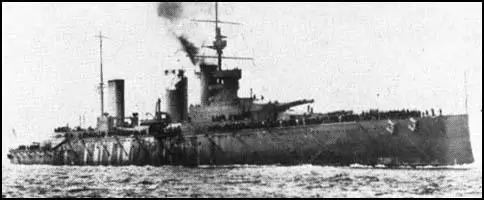Battlecruisers
A battlecruiser had the speed of a cruiser and the striking power of a battleship. It was Admiral John Fisher, the First Sea Lord, who first suggested the idea of battlecruisers. The first three battlecruisers; Invincible, Indomitable and Inflexible , were completed was the Royal Navy in 1908. Fisher argued that if a battlecruiser could not destroy a battleship it was attacking, it would always be fast enough to escape. The Germany Navy followed Britain's example and also began building battlecruisers.
In 1912 produced three new battlecruisers that became known as the Big Cats ( Lion , Queen Mary and the Princess Royal ). The Queen Mary , with its 13.5-inch guns, was the largest ship in the Royal Navy.
Events in the First World War revealled that although battlecruisers could be impressive in attack, they had defensive weaknesses. Inflexible was badly damaged by a mine at Gallipoli and Invincible exploded and sank after a hit from a German ship during the Battle of Jutland. Queen Mary was also sunk at Jutland with the loss of almost 1,300 lives.
The Hood was considered Britain's greatest battlecruiser. Her construction was begun in 1916 and she was completed in August 1918. Her armament consisted of eight 15-inch guns (380 mm) placed in four turrets. There were also twelve 5.5 inch guns (140 mm) and four anti-aircraft 4 inch guns (102 mm). The Hood had two underwater and four surface 21 inch torpedo tubes (533 mm). The maximum speed was 31 knots and had a crew of 1,341 men.


